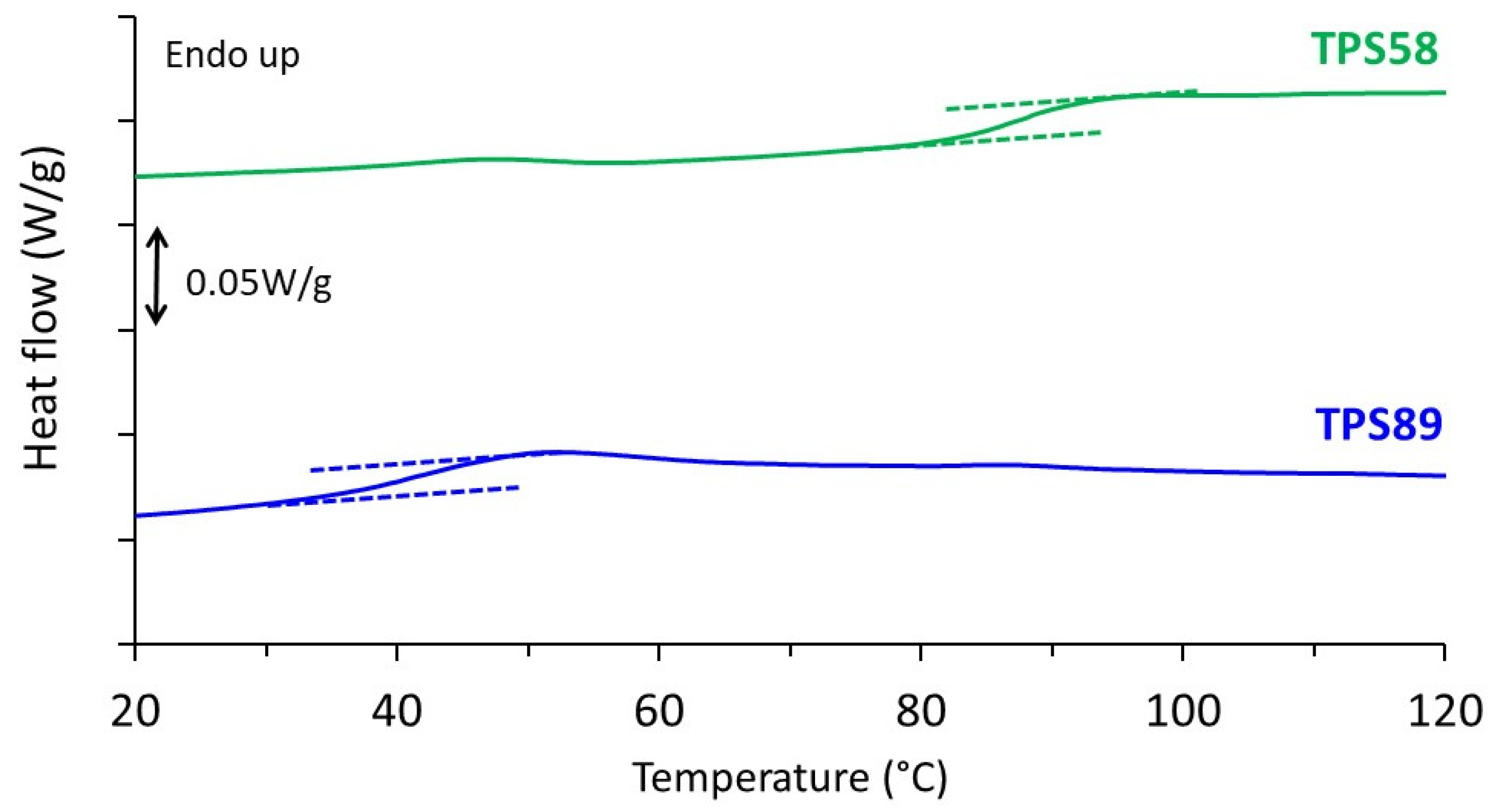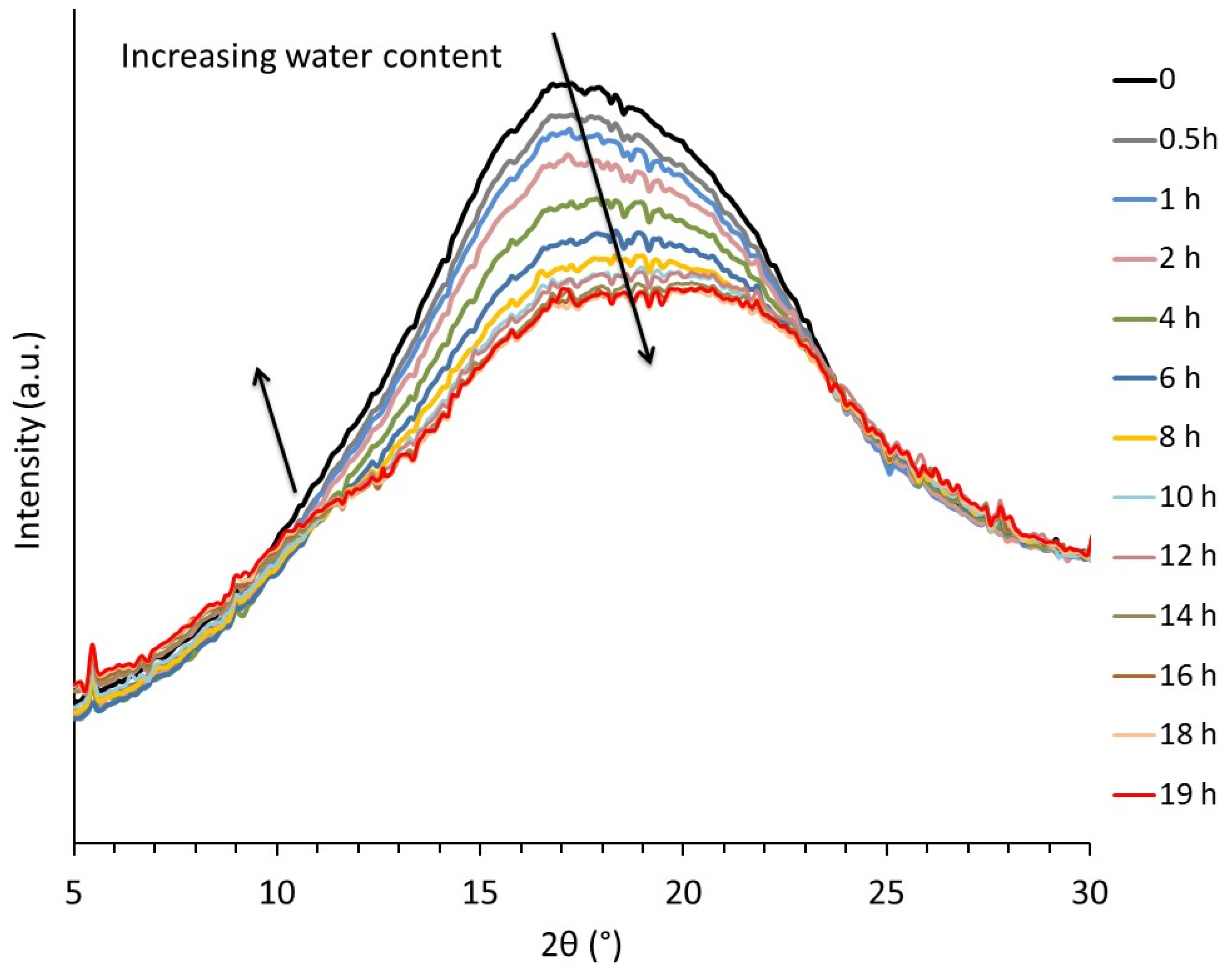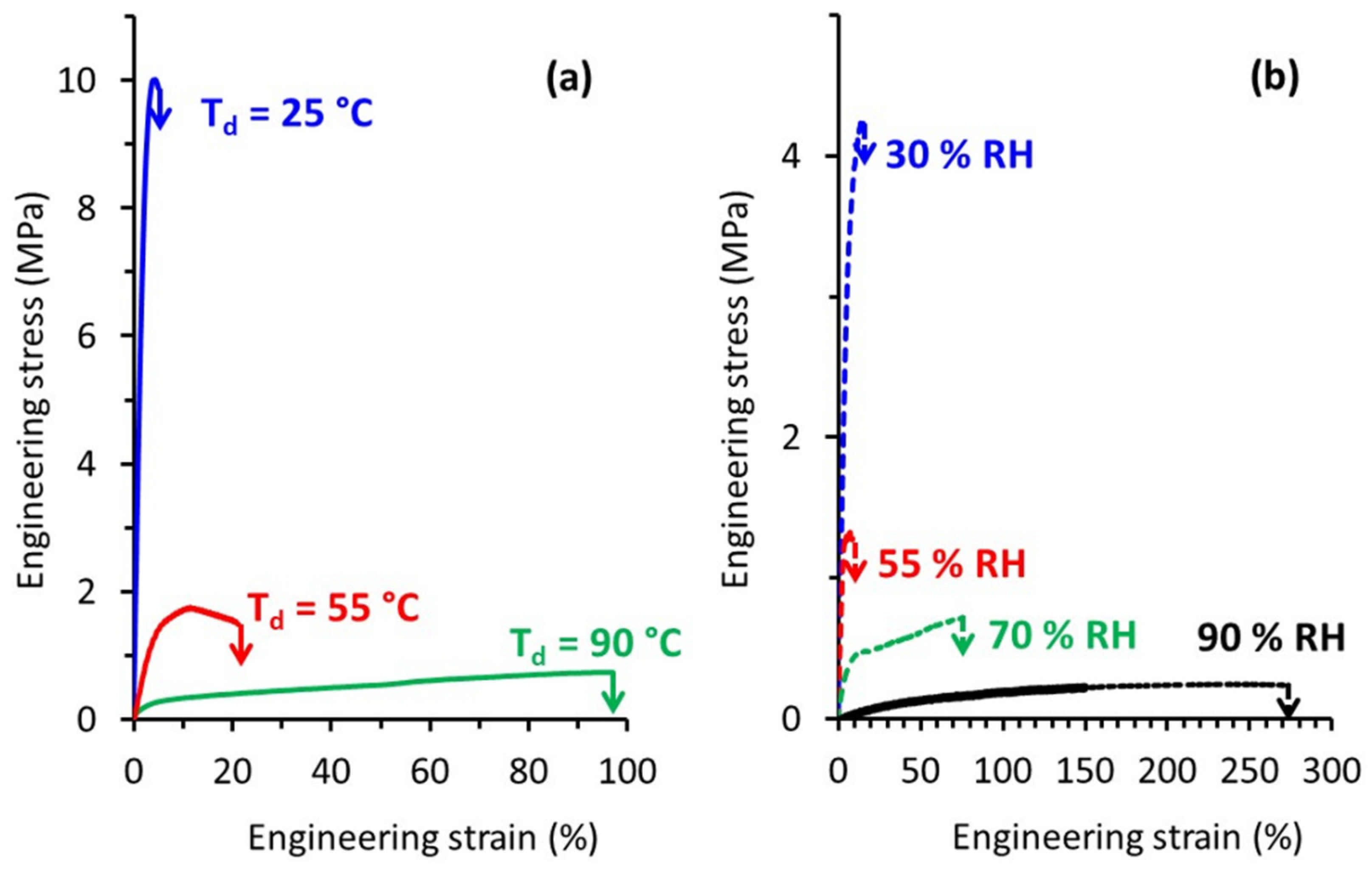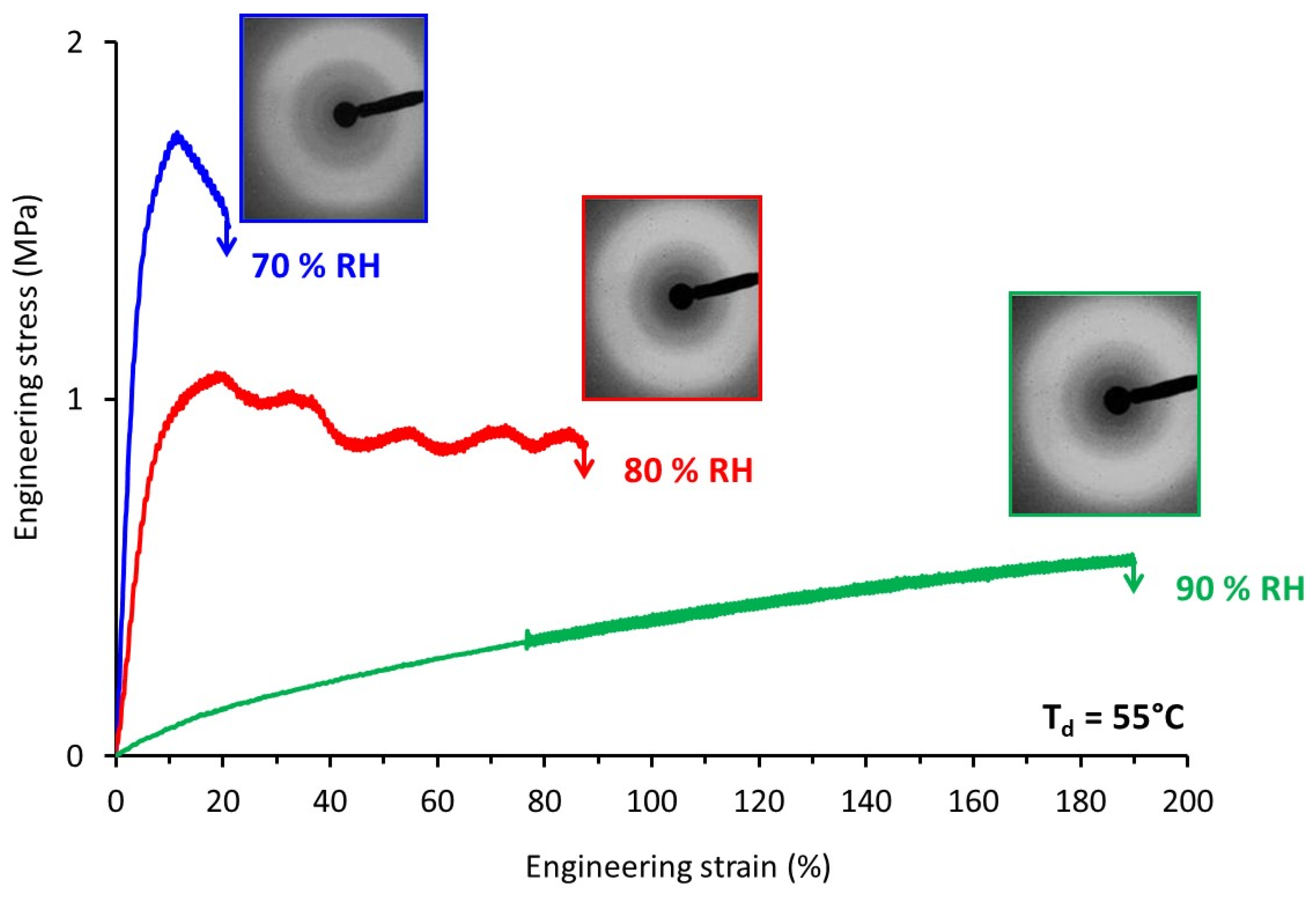Mechanical Behavior of Thermoplastic Starch: Rationale for the Temperature-Relative Humidity Equivalence
Abstract
:1. Introduction
2. Materials and Methods
2.1. Extrusion of Potato Starch
2.2. Elaboration of TPS Samples and Conditioning
2.3. Thermal Behaviour
2.4. Structural Analysis
2.5. Uniaxial Tensile Behavior
3. Results and Discussion
3.1. Characterization of TPS58 and TPS89
3.2. Mechanical Behaviour
3.3. Structural Evolution during Stretching
4. Conclusions
Author Contributions
Funding
Institutional Review Board Statement
Informed Consent Statement
Data Availability Statement
Acknowledgments
Conflicts of Interest
References
- Souza, R.C.R.; Andrade, C.T. Investigation of the gelatinization and extrusion processes of corn starch. Adv. Polym. Tech. 2002, 21, 17–24. [Google Scholar] [CrossRef]
- Stepto, R.F.T. The processing of starch as a thermoplastic. Macromol. Symp. 2003, 201, 203–212. [Google Scholar] [CrossRef]
- Stepto, R.F.T. Understanding the processing of thermoplastic starch. Macromol. Symp. 2006, 245, 571–577. [Google Scholar] [CrossRef]
- Stepto, R.F.T. Thermoplastic starch. Macromol. Symp. 2009, 279, 163–168. [Google Scholar] [CrossRef]
- Van Der Burgt, M.C.; Van Der Woude, M.E.; Janssen, L.P.B.M. The influence of plasticizer on extruded thermoplastic starch. J. Vinyl Addit. Technol. 1996, 2, 170–174. [Google Scholar] [CrossRef] [Green Version]
- Bendaoud, A.; Chalamet, Y. Effects of relative humidity and ionic liquids on the water content and glass transition of plasticized starch. Carbohydr. Polym. 2013, 97, 665–675. [Google Scholar] [CrossRef]
- Sankri, A.; Arhaliass, A.; Dez, I.; Gaumont, A.C.; Grohens, Y.; Lourdin, D.; Pillin, I.; Rolland-Sabaté, A.; Leroy, E. Thermoplastic starch plasticized by an ionic liquid. Carbohydr. Polym. 2010, 82, 256–263. [Google Scholar] [CrossRef]
- Wang, H.; Huang, M. Preparation, characterization and performances of biodegradable thermoplastic starch. Polym. Adv. Technol. 2007, 18, 910–915. [Google Scholar] [CrossRef]
- Forssell, P.M.; Hulleman, S.H.D.; Myllärinen, A.P.J.; Moates, G.K.; Parker, R. Ageing of rubbery thermoplastic barley and oat starches. Carbohydr. Polym. 1999, 39, 43–51. [Google Scholar] [CrossRef]
- Gaudin, S.; Lourdin, D.; Forssell, P.M.; Colonna, P. Antiplasticisation and oxygen permeability of starch-sorbitol films. Carbohydr. Polym. 2000, 43, 33–37. [Google Scholar] [CrossRef]
- Mikus, P.; Alix, S.; Soulestin, J.; Lacrampe, M.F.; Krawczak, P.; Coqueret, X.; Dole, P. Deformation mechanisms of plasticized starch materials. Carbohydr. Polym. 2014, 114, 450–457. [Google Scholar] [CrossRef]
- Thunwall, M.; Boldizar, A.; Rigdahl, M. Compression molding and tensile properties of thermoplastic potato starch materials. Biomacromolecules 2006, 7, 981–986. [Google Scholar] [CrossRef]
- Van Soest, J.J.G.; De Wit, D.; Vliegenthart, J.F.G. Mechanical properties of thermoplastic waxy maize starch. J. Appl. Polym. Sci. 1996, 61, 1927–1937. [Google Scholar] [CrossRef]
- Hulleman, S.H.D.; Janssen, F.H.P.; Feil, H. The role of water during plasticization of native starches. Polymer 1998, 39, 2043–2048. [Google Scholar] [CrossRef]
- Lourdin, D.; Valle, G.D.; Colonna, P. Influence of amylose content on starch films and foams. Carbohydr. Polym. 1995, 27, 261–270. [Google Scholar] [CrossRef]
- Dieulot, J.; Skurtys, O. Classification, modeling and prediction of the mechanical behavior of starch-based films. J. Food Eng. 2013, 119, 188–195. [Google Scholar] [CrossRef]
- Véchambre, C.; Buléon, A.; Chaunier, L.; Jamme, F.; Lourdin, D. Macromolecular orientation in glassy starch materials that exhibit shape memory behavior. Macromolecules 2010, 43, 9854–9858. [Google Scholar] [CrossRef]
- Véchambre, C.; Buléon, A.; Chaunier, L.; Gauthier, C.; Lourdin, D. Understanding the mechanisms involved in shape memory starch: Macromolecular orientation, stress recovery and molecular mobility. Macromolecules 2011, 44, 9384–9389. [Google Scholar] [CrossRef]
- Coativy, G.; Gautier, N.; Pontoire, B.; Buléon, A.; Lourdin, D.; Leroy, E. Shape memory starch-clay bionanocomposites. Carbohydr. Polym. 2015, 116, 307–313. [Google Scholar] [CrossRef]
- Bizot, H.; Le Bail, P.; Leroux, B.; Davy, J.; Roger, P.; Buleon, A. Calorimetric evaluation of the glass transition in hydrated, linear and branched polyanhydroglucose compounds. Carbohydr. Polym. 1997, 32, 33–50. [Google Scholar] [CrossRef]
- Lourdin, D.; Coignard, L.; Bizot, H.; Colonna, P. Influence of equilibrium relative humidity and plasticizer concentration on the water content and glass transition of starch materials. Polymer 1997, 38, 5401–5406. [Google Scholar] [CrossRef]
- Chung, H.J.; Lim, S.T. Physical aging of amorphous starches (a review). Starch/Staerke 2006, 58, 599–610. [Google Scholar] [CrossRef]
- Ferry, J. Viscoelastic Properties of Polymers, 3rd ed.; Wiley: New York, NY, USA, 1980. [Google Scholar]
- Semsarzadeh, M.A.; Mehrabzadeh, M.; Arabshabi, S.S. Dynamic mechanical behavior of the dioctyl phthalate plasticized polyvinyl chloride-epoxidized soya bean oil. Eur. Polym. J. 2002, 38, 351–358. [Google Scholar] [CrossRef]
- Sheth, M.; Kumar, R.A.; Davé, V.; Gross, R.A.; McCarthy, S.P. Biodegradable polymer blends of poly (lactic acid) and poly (ethylene glycol). J. Appl. Polym. Sci. 1997, 66, 1495–1505. [Google Scholar] [CrossRef]
- Graessley, W.W.; Edwards, S.F. Entanglement interactions in polymers and the chain contour concentration. Polymer 1981, 22, 1329–1334. [Google Scholar] [CrossRef]
- Bayer, R.K.; Cagiao, M.E.; Baltá Calleja, F.J. Structure development in amorphous starch as revealed by X-ray scattering: Influence of the network structure and water content. J. Appl. Polym. Sci. 2006, 99, 1880–1886. [Google Scholar] [CrossRef] [Green Version]
- Stoclet, G.; Seguela, R.; Lefebvre, J.M.; Elkoun, S.; Vanmansart, C. Strain-induced molecular ordering in polylactide upon uniaxial stretching. Macromolecules 2010, 43, 1488–1498. [Google Scholar] [CrossRef]
- Miri, V.; Persyn, O.; Lefebvre, J.-M.; Seguela, R. Effect of water absorption on the plastic deformation behavior of nylon 6. Eur. Polym. J. 2009, 45, 757–762. [Google Scholar] [CrossRef]






| Stretching Conditions | R.H. = 70% | T = 80 °C | |||||
|---|---|---|---|---|---|---|---|
| T (°C) | R. H. (%) | ||||||
| 25 | 55 | 90 | 30 | 55 | 70 | 90 | |
| E (MPa) | 420 ± 100 | 30 ± 10 | 6 ± 1 | 80 ± 10 | 45 ± 10 | 7 ± 3 | 0.4 ± 0.1 |
| σbreak (MPa) | 10 ± 1 | 1.5 ± 0.5 | 0.8 ± 0.3 | 4 ± 1 | 1.3 ± 0.5 | 0.7 ± 0.3 | 0.3 ± 0.2 |
| εbreak (%) | 4 ± 1 | 22 ± 6 | 100 ± 10 | 15 ± 4 | 12 ± 6 | 80 ± 25 | 240 ± 80 |
| Td (°C) | R.H. (%) | Water Content (g H2O/g Total) (% ± 1) | Tg (°C ± 5) | ΔT = Td − Tg (°C) |
|---|---|---|---|---|
| 25 | 70 | 16 | 60 | −35 |
| 55 | 70 | 17 | 50 | 5 |
| 90 | 70 | 16 | 60 | 30 |
| 80 | 30 | 12 | 90 | −10 |
| 80 | 55 | 14 | 75 | 5 |
| 80 | 70 | 17 | 50 | 30 |
| 80 | 90 | 20 | 30 | 50 |
Publisher’s Note: MDPI stays neutral with regard to jurisdictional claims in published maps and institutional affiliations. |
© 2022 by the authors. Licensee MDPI, Basel, Switzerland. This article is an open access article distributed under the terms and conditions of the Creative Commons Attribution (CC BY) license (https://creativecommons.org/licenses/by/4.0/).
Share and Cite
Leroy, L.; Stoclet, G.; Lefebvre, J.-M.; Gaucher, V. Mechanical Behavior of Thermoplastic Starch: Rationale for the Temperature-Relative Humidity Equivalence. Polymers 2022, 14, 2531. https://doi.org/10.3390/polym14132531
Leroy L, Stoclet G, Lefebvre J-M, Gaucher V. Mechanical Behavior of Thermoplastic Starch: Rationale for the Temperature-Relative Humidity Equivalence. Polymers. 2022; 14(13):2531. https://doi.org/10.3390/polym14132531
Chicago/Turabian StyleLeroy, Lise, Gregory Stoclet, Jean-Marc Lefebvre, and Valerie Gaucher. 2022. "Mechanical Behavior of Thermoplastic Starch: Rationale for the Temperature-Relative Humidity Equivalence" Polymers 14, no. 13: 2531. https://doi.org/10.3390/polym14132531
APA StyleLeroy, L., Stoclet, G., Lefebvre, J.-M., & Gaucher, V. (2022). Mechanical Behavior of Thermoplastic Starch: Rationale for the Temperature-Relative Humidity Equivalence. Polymers, 14(13), 2531. https://doi.org/10.3390/polym14132531






